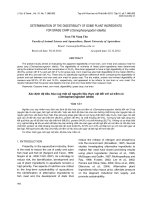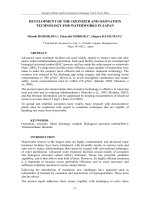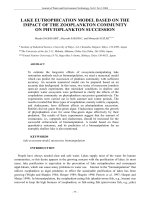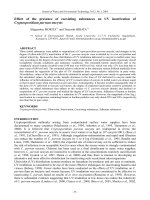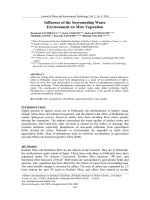Computational Prototyping of the Programmable Fluid Processor
Bạn đang xem bản rút gọn của tài liệu. Xem và tải ngay bản đầy đủ của tài liệu tại đây (175.32 KB, 1 trang )
Figure 2: Three electrostatic forces contribute to
the droplet migration: the DEP in the volume an
d
droplet surface, the EWOD at the triphase
(droplet, suspending liquid, hydrophobic coatin
g
surface) contact trace.
Electro
-
wetting
DEP
-
field non
-
uniformity
DEP
-
dielectric discontinuity
Electro
-
wetting
DEP
-
field non
-
uniformity
DEP
-
dielectric discontinuity
Figure 3: Sample simulation visualization. A charged
neighboring electrode generates a non-uniform electric field
that will induce the droplet to migrate. The droplet surface is
colored by the electric potential. (The insulating fluid and th
e
hydrophobic coating layer are removed for clarity).
Computational Prototyping of the Programmable Fluid Processor
Jun Zeng and Tom Korsmeyer
Coventor, Inc.
The Programmable Fluid Processor (PFP), currently under development at M. D. Anderson Cancer Center,
will have applications in disease screening, environmental monitoring, and battlefield detection of
biochemical agents [1]. In this device, an electrostatic field exerts forces on dielectric droplets suspended
in an immiscible insulating liquid medium. This phenomenon is known as dielectrophoresis (DEP). The
electrostatic field is generated by an array of
electrodes, each of which is addressable so that a
droplet, or a group of droplets, can be directed to
desired locations, where the droplets can merge,
mix, and split. The droplets are used as carriers of
different chemical compounds so that a programmed
chemical assay can be conducted. Recent advances
in semiconductor manufacturing technology have
enabled researchers to fabricate such BioChips at the
size of less than a centimeter [2].
The design of the PFP and its operating programs calls for a detailed understanding of DEP-driven droplet
formation and migration; that is, droplet behavior with a given electrode configuration must be reliably
predicted. This demands full-dimensional, transient, simulation capabilities that incorporate
electromechanics and multiphase-flow hydrodynamics. The work reported here addresses such a
simulation need for the first time.
We describe a full-dimensional, transient, electrohydrodynamics, numerical simulation tool based on a
proven computational fluid dynamics technique [3]. We present the results of this simulation tool from an
investigation of droplet dielectrophoresis in the context of the PFP. These include a study of droplet
migration under a non-uniform electric field and a study of the effects on droplet behavior of droplet
dimension, electrode dimension, electrode spacing, and dielectric coating.
Zeng and Korsmeyer acknowledge the support of The Defense Advanced Research Projects Agency (DARPA)
under contract DAAD10-00-1-0515 from the Army Research Office to the University of Texas M.D. Anderson
Cancer Center.
Contact Author: Jun Zeng, Ph.D., Coventor Inc., 625 Mount Auburn Street, Cambridge, MA 02138
Ph: 617-497-6880 ext. 259 Fax: 617-497-6882 E-mail:
Reference
[1] J. Vykoukal, J. A. Schwartz, F. F. Becker and P. R. C. Gascoyne, “A Programmable Dielectrophoretic Fluid Processor For
Droplet-based Chemistry”, Proceedings of the µTAS 2001 Symposium, Kluwer Academic Publishers, pp. 72-74
[2] P. Krulevitch, “Polymer-based Biomedical Microsystems”, BioMEMS 2002, April 25-26, 2002, Boston, MA
[3] C. W. Hirt and B. D. Nichols, 1981, “Volume of Fluid (VOF) Method for the Dynamics of Free Boundaries”, Journal of
Computational Physics, Vol. 39, pp. 201-225
Figure 1: Elevation view of the Programmable Fluid
Processor.

